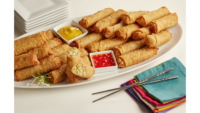Snack Food & Wholesale Bakery was recently able to talk to Doug Resh, director, commercial marketing, T. Hasegawa USA, Cerritos, CA, about trends in Asian flavors in frozen snacks.
Liz Parker: Speaking specifically to frozen Asian foods (appetizers) and salty snacks, how does Asian cuisine benefit from a “health halo”?
Doug Resh: One of the greatest strengths of Asian cuisine is the implied "health halo" that these foods deliver. More than 60% of participants in a recent Mintel survey stated they associate Asian cuisine with offering a good variety of flavors and 42% associated Asian foods with being healthy. These consumer perceptions indicate a major market opportunity for brands who can tap into the rich flavors of Asian cuisine while also fitting into trending plant-based or flexitarian diets that are currently popular among younger consumers. More than 39% of consumers in the Mintel study cited they would like to eat more Asian ingredients that are healthy, indicating further opportunity for future growth in this category.
The implied "health halo" of Asian cuisine has even more potential in categories like snacks, which are traditionally dominated by options that are high in sugar and sodium, and not generally considered healthy. The abundance of rich flavors in Asian cuisine, such as spiciness and umami allow plenty of versatility in the snack category without relying on excessive sugar or sodium. Traditional Asian condiment flavors such as yuzu kosho sauce deliver a fiery, umami-rich complexity to salted snack foods, while fermented flavors like kimchi and matcha are increasingly used in development of many different snack foods. Culinary flavors like tikki masala and Thai curry are rapidly becoming mainstream and moving beyond traditional Asian frozen appetizers and entrees into fusion foods across the freezer section.
The key to this growth is the consumer perception of Asian foods as a source of flavor excitement and a healthier option than other cuisine. No other flavor category can deliver the diversity of bold flavors that Asian foods can, with minimal reliance on sugar, salt and even dairy products.
LP: What are some good way to combine adventurous Asian flavors and ingredients with already popular varieties?
DR: An Asian cuisine trend that continues to grow each year in the foodservice category is fusion foods—and this trend is extending to the supermarket as well. A uniquely American creation, fusion food blends the familiarity of multiple international flavors into a unique new dish. Fusion food is becoming an increasingly popular with gourmet food trucks and pop-up restaurants, producing unique creations such as bulgogi tacos. This flavorful dish fuses a Mexican classic with sweet and spicy Korean beef, topped with creamy gochujang chili sauce. Traditionally, restaurants are the pathway to introducing new flavors to consumers and have a large influence on at-home cooking trends and the development of new packaged food flavors. The pandemic only fueled the trend of consumers replicating their favorite restaurant dishes at home, and even experimenting with at-home fusion, adding chili-based sauces like sambal, gochujang, sriracha, and chili crisp to provide a distinctly Asian profile to other types of dishes.
This increased consumer interest in adventurous Asian flavors and fusion foods in restaurants and home kitchens can also be leveraged in the development of frozen entrees and appetizers and other packaged meals, along with a broad range of snack categories. Savvy food brands can introduce Asian flavors into new products by tapping into the familiarity that consumers find in comfort foods throughout the supermarket and layering these favorites with the unique profile of Asian flavors.
LP: What is the best way to mix Asian flavors into snacking?
DR: The key to increasing Asian flavors into the snacking category is to leverage what already exists within Asian flavors and what consumers already love about these foods. Some of the aspects that consumers love the most about Asian cuisine are perfectly positioned for the snack category – especially chili-based heat.
Many Asian cuisines are notoriously spicy—and consumers apparently can’t get enough. In fact, the total market for hot sauce in North America is currently over $1.13 Billion with a CAGR of 7.1% through 2028. The U.S. and Canada account for more than 40% of the global chili hot sauce market, showing impressive demand and future growth of this category. As consumer tastes shift toward increasingly hotter items, brands are seeking creative ingredients and flavors sourced from Asian cuisine to deliver on the demand for fiery foods, such as gochujang, a red chili-based fermented sauce that offers a sweet and spicy kick to savory foods. Poised to become the "next sriracha," gochujang is expanding from Korean restaurants and food trucks to mainstream supermarkets across the U.S. as a flavor for potato chips, pretzels, and other salty snacks, mirroring the impressive mainstream growth of sriracha sauce over the last decade.
.jpeg?1649176219)





